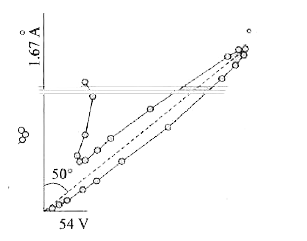a. Name the experiment which establishes the wave nature of moving electrons.
b. In that experiment, electrons are accelerated through a potential of 54 V and is made to fall normally on the nickel crystal of interatomic separation 0.91 A. Draw the polar graph showing the variation of intensity of the scattered electrons electrons and latitude angle at this potential.
c. Calculate the d-Broglie wavelength of the electron. Solution in Tamil
a. Davisson-Germer experiment.
b. 
c. Intensity decreases with latitude angle and then increases to maximum at 50∘
d. λ=hp=h√2mE=6.63×10−34√2×9.1×10−31×5.4×1.6×10−19=1.67Å
Topper's Solved these Questions
- BOOK - NEW JOYTHI PUBLICATIONCHAPTER - DUAL NATURE OF RADIATION AND MATTER EXERCISE - CONTINUOUS EVALUATION (ASSIGNMENT)4videos
DUAL NATURE OF RADIATION AND MATTER
- BOOK - NEW JOYTHI PUBLICATIONCHAPTER - DUAL NATURE OF RADIATION AND MATTER EXERCISE - PREVIOUS YEAR QUESTIONS4videos
DUAL NATURE OF RADIATION AND MATTER
- BOOK - NEW JOYTHI PUBLICATIONCHAPTER - DUAL NATURE OF RADIATION AND MATTER EXERCISE - PRACTICE PROBLEMS FOR SELF ASSESSMENT5videos
DUAL NATURE OF RADIATION AND MATTER
- BOOK - NEW JOYTHI PUBLICATIONCHAPTER - CURRENT ELECTRICITYEXERCISE - COMPETITIVE EXAM CORNER37videos
CURRENT ELECTRICITY
- BOOK - NEW JOYTHI PUBLICATIONCHAPTER - ELECTRIC CHARGES AND FIELDS EXERCISE - Competitive Exam Corner20videos
ELECTRIC CHARGES AND FIELDS
Similar Questions
Discuss the various modes of emission of electron.
03:27View SolutionAlbert Einstein, the great physist proposed a clear picture to explain photoelectric effect.
a. Explain Einstein's photo electric equation.
b. Name the quanta of light.View SolutionWhat is the energy of an α particle that has been accelerated through 50,000 V ?
View SolutionAn electric bulb rated 500 W at 100 V is used in a circuit having a 200 V supply. The resistance R that must be put in series with the bulb, so that the bulb draws 500 W is
01:08View SolutionTwo charged spherical conductors of radii R1andR2 are connected by a wire. Then the ratio of surface charge densitites of the spheres σ1/σ2 is
02:31View SolutionShow graphically, the variation of the de-Broglie wavelength (λ) with the potential (V) through which an electron is accelerated from rest.
06:26View SolutionA chemist was performing an experiment to study the effect of varying voltage on the velocity and de Broglie wavelength of the electrons. In first experiment, the electron was accelerated through a potential difference of 1kV and in second experiment, it was accelerated through a potential difference of 2kV.
The wavelength of de Broglie waves associated with electron is given by:
λ=h√2qVm
where, V is the voltage through which an electron is accelerated.
Putting the values of h, m and q we get:
λ=12.3√VÃ…
Q. The wavelength of electron will be:02:48View SolutionA chemist was performing an experiment to study the effect of varying voltage on the velocity and de Broglie wavelength of the electrons. In first experiment, the electron was accelerated through a potential difference of 1kV and in second experiment, it was accelerated through a potential difference of 2kV. The wavelength of de Broglie waves associated with electron is given by: lamda=(h)/(sqrt(2qVm)) where, V is the voltage through which an electron is accelerated. Putting the values of h, m and q we get: lamda=(12.3)/(sqrt(V)) Ã… Q. The velocity of electron will be:
02:20View SolutionThe de Broglie wavelength λ of an electron accelerated through a potential V in volts is
04:36View SolutionIf the accelerating potential in Davisson and Germer experiment is 54 V, the de-Broglie wavelength of the electron is
View Solution56 V विभवांतर द्वारा त्वरीत एलेक्ट्रॉनों का (a) संवेग और (b) द ब्रॉग्ली तरंगदैर्ध्य की गणना करें ।
02:42View SolutionThe de Broglie wavelength of electron accelerated with a potential V is ____________.
02:00View Solution400 V विभवान्तर से त्वरित इलेक्ट्रॉन से सम्बद्ध दे-ब्रॉग्ली तरंगदैर्ध्य की गणना कीजिए।
02:37View SolutionDerive expression for the de-Broglie wavelength of an electron moving under a potential difference of V volt. Name an experiment which verified the wave nature of electrons.
02:27View SolutionShow graphically, the variation of the de-Broglie wavelength (λ) with the potential (V) through which an electron is accelerated from rest.
03:55View Solution

